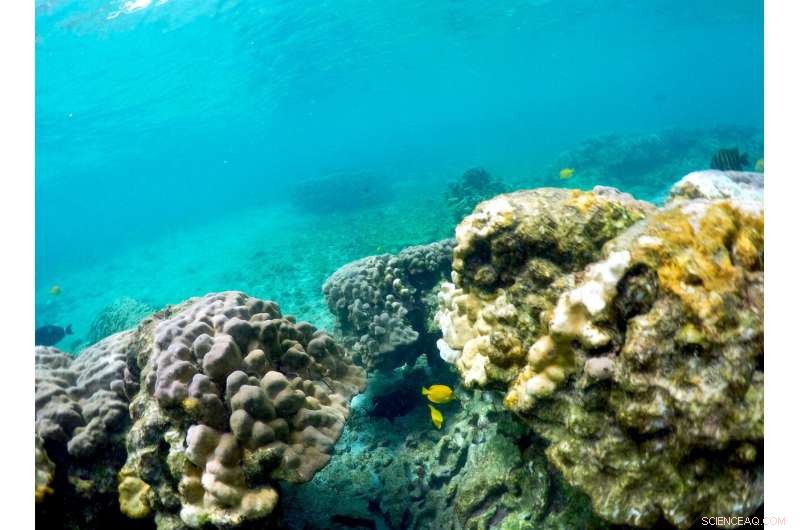
Ce 12 septembre La photo de 2019 montre le blanchissement du corail dans la baie de Kahala'u à Kailua-Kona, Hawaii. Quatre ans seulement après qu'une importante vague de chaleur marine ait tué près de la moitié des coraux de ce littoral, des chercheurs fédéraux prédisent qu'une nouvelle vague d'eau chaude provoquera le pire blanchissement des coraux que la région ait jamais connu. (Photo AP/Caleb Jones)
Au bord d'une ancienne coulée de lave où les roches noires déchiquetées rencontrent le Pacifique, de petites maisons hors réseau surplombent les eaux calmes et bleues de Papa Bay sur la grande île d'Hawaï, sans touristes ni hôtels en vue. Ici, l'un des récifs coralliens les plus abondants et les plus dynamiques de l'île se développe juste sous la surface.
Pourtant, même ce rivage éloigné des impacts des crèmes solaires chimiques, Le piétinement des pieds et les eaux usées industrielles montrent les premiers signes de ce qui devrait être une saison catastrophique pour le corail à Hawaï.
Quatre ans seulement après qu'une importante vague de chaleur marine ait tué près de la moitié des coraux de ce littoral, des chercheurs fédéraux prédisent qu'une autre vague d'eau chaude provoquera l'un des pires blanchissements coralliens que la région ait jamais connus.
« En 2015, nous atteignons des températures que nous n'avons jamais enregistrées à Hawaï, " a déclaré Jamison Gove, océanographe à la National Oceanic and Atmospheric Administration. "Ce qui est vraiment important - ou alarmant, probablement plus approprié - à propos de cet événement, c'est que nous avons suivi ci-dessus où nous étions à ce moment-là en 2015. "
Les chercheurs utilisant des équipements de haute technologie pour surveiller les récifs d'Hawaï voient les premiers signes de blanchissement dans la baie de Papa et ailleurs causés par une vague de chaleur marine qui a fait monter les températures à des niveaux record pendant des mois. Juin, Juillet et certaines parties d'août ont tous connu les températures océaniques les plus chaudes jamais enregistrées autour des îles hawaïennes. Jusqu'à présent en septembre, les températures océaniques sont inférieures uniquement à celles observées en 2015.

Ce 12 septembre La photo de 2019 montre un poisson près du corail dans une baie de la côte ouest de la grande île près du capitaine Cook, Hawaii. Quatre ans seulement après qu'une importante vague de chaleur marine ait tué près de la moitié des coraux de ce littoral, des chercheurs fédéraux prédisent qu'une nouvelle vague d'eau chaude provoquera le pire blanchissement des coraux que la région ait jamais connu. (Photo AP/Brian Skoloff)
Les prévisionnistes s'attendent à ce que les températures élevées dans le Pacifique nord continuent de pomper de la chaleur dans les eaux d'Hawaï jusqu'en octobre.
"Les températures sont chaudes depuis assez longtemps, " a déclaré Gove. " Ce n'est pas seulement à quel point il fait chaud. C'est la durée pendant laquelle ces températures océaniques restent chaudes."
Les récifs coralliens sont vitaux dans le monde entier car ils fournissent non seulement un habitat aux poissons - la base de la chaîne alimentaire marine - mais aussi de la nourriture et des médicaments pour les humains. Ils créent également une barrière de rivage essentielle qui brise les grandes houles océaniques et protège les rivages densément peuplés des ondes de tempête pendant les ouragans.
À Hawaii, les récifs sont également une partie importante de l'économie :le tourisme prospère en grande partie grâce aux récifs coralliens qui aident à créer et à protéger des plages de sable blanc emblématiques, proposer des spots de snorkeling et de plongée, et aidez à former des vagues qui attirent les surfeurs du monde entier.

Ce 12 septembre La photo de 2019 montre le blanchissement du corail dans la baie de Kahala'u à Kailua-Kona, Hawaii. Quatre ans seulement après qu'une importante vague de chaleur marine ait tué près de la moitié des coraux de ce littoral, des chercheurs fédéraux prédisent qu'une nouvelle vague d'eau chaude provoquera le pire blanchissement des coraux que la région ait jamais connu. (Photo AP/Caleb Jones)
Les températures océaniques ne sont pas uniformément chaudes dans tout l'État, Gove a noté. Vents locaux, les courants et même les caractéristiques terrestres peuvent créer des points chauds dans l'eau.
"Vous avez des choses comme deux volcans géants sur la grande île qui bloquent les alizés prédominants, " faire la côte ouest de l'île, où se trouve Papa Bay, l'une des parties les plus chaudes de l'état, dit Gove. Il a dit qu'il s'attend à un blanchissement "sévère" des coraux dans ces endroits.
"C'est répandu, Blanchiment à 100% de la plupart des coraux, " a déclaré Gove. Et beaucoup de ces coraux se remettent encore de l'événement de blanchissement de 2015, ce qui signifie qu'ils sont plus sensibles au stress thermique.
Selon la NOAA, les causes de la vague de chaleur incluent un régime météorologique de basse pression persistant entre Hawaï et l'Alaska qui a affaibli les vents qui pourraient autrement mélanger et refroidir les eaux de surface dans une grande partie du Pacifique Nord. La cause n'est pas claire :cela pourrait refléter le mouvement chaotique habituel de l'atmosphère, ou cela pourrait être lié au réchauffement des océans et à d'autres effets du changement climatique d'origine humaine.
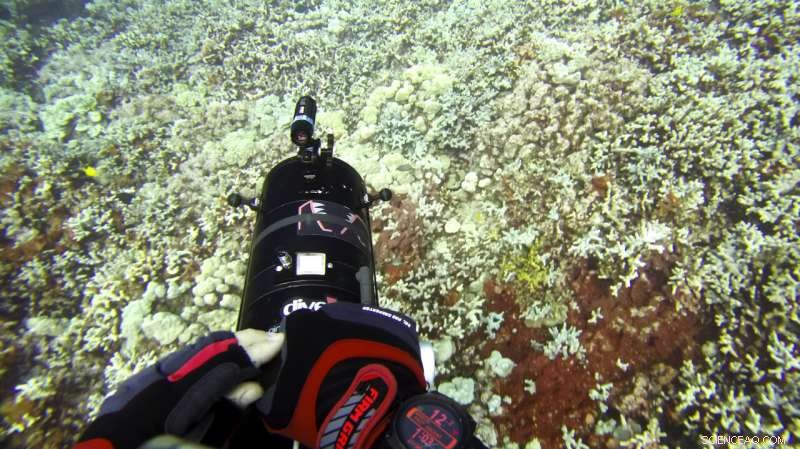
En ce 13 septembre, Image 2019 tirée d'une vidéo fournie par le Center for Global Discovery and Conservation Science de l'Arizona State University, l'écologiste Greg Asner plonge au-dessus d'un récif de corail à Papa Bay près du capitaine Cook, Hawaii. "Presque toutes les espèces que nous surveillons ont au moins un peu de blanchissement, ", a déclaré Asner. (Centre pour la découverte mondiale et la science de la conservation de l'Université d'État de l'Arizona via AP)
Au-delà de cet événement, oceanic temperatures will continue to rise in the coming years, Gove said. "There's no question that global climate change is contributing to what we're experiencing, " il a dit.
For coral, hot water means stress, and prolonged stress kills these creatures and can leave reefs in shambles.
Bleaching occurs when stressed corals release algae that provide them with vital nutrients. That algae also gives the coral its color, so when it's expelled, the coral turns white.
Gove said researchers have a technological advantage for monitoring and gleaning insights into this year's bleaching, data that could help save reefs in the future.
"We're trying to track this event in real time via satellite, which is the first time that's ever been done, " Gove said.
In remote Papa Bay, most of the corals have recovered from the 2015 bleaching event, but scientists worry they won't fare as well this time.
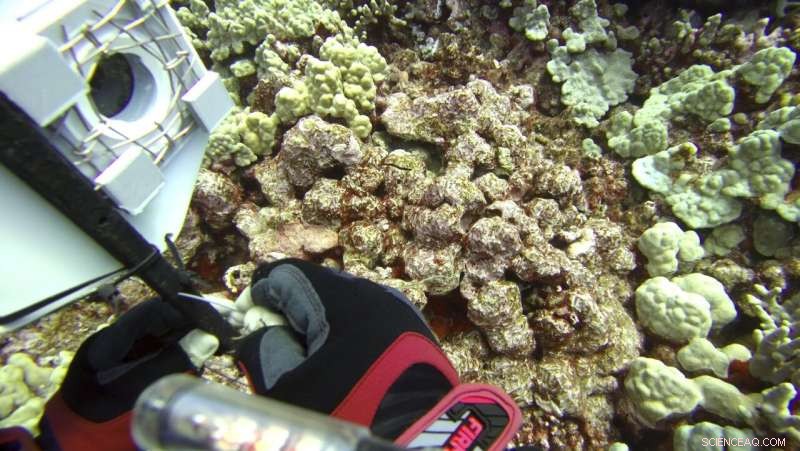
En ce 13 septembre, 2019, image taken from video provided by Arizona State University's Center for Global Discovery and Conservation Science, ecologist Greg Asner prepares a camera fish trap on a coral reef in Papa Bay near Captain Cook, Hawaii. "Nearly every species that we monitor has at least some bleaching, " Asner said. (Greg Asner/Arizona State University's Center for Global Discovery and Conservation Science via AP)
"Nearly every species that we monitor has at least some bleaching, " said ecologist Greg Asner, director of Arizona State University's Center for Global Discovery and Conservation Science, after a dive in the bay earlier this month.
Asner told The Associated Press that sensors showed the bay was about 3.5 degrees Fahrenheit above what is normal for this time of year.
He uses advanced imaging technology mounted to aircrafts, données satellitaires, underwater sensors and information from the public to give state and federal researchers like Gove the information they need.
"What's really important here is that we're taking these (underwater) measurements, connecting them to our aircraft data and then connecting them again to the satellite data, " Asner said. "That lets us scale up to see the big picture to get the truth about what's going on here."

En ce 13 septembre, 2019 image taken from video provided by Arizona State University's Center for Global Discovery and Conservation Science, ecologist Greg Asner dives over a coral reef in Papa Bay near Captain Cook, Hawaii. "Nearly every species that we monitor has at least some bleaching, " Asner said. (Greg Asner/Arizona State University's Center for Global Discovery and Conservation Science via AP)
Scientists will use the information to research, entre autres, why some coral species are more resilient to thermal stress. Some of the latest research suggests slowly exposing coral to heat in labs can condition them to withstand hotter water in the future.
"After the heat wave ends, we will have a good map with which to plan restoration efforts, " Asner said.
Pendant ce temps, Hawaii residents like Cindi Punihaole Kennedy are pitching in by volunteering to educate tourists. Punihaole Kennedy is director of the Kahalu'u Bay Education Center, a nonprofit created to help protect Kahalu'u Bay, a popular snorkeling spot near the Big Island's tourist center of Kailua-Kona.
The bay and surrounding beach park welcome more than 400, 000 visitors a year, elle a dit.
"We share with them what to do and what not to do as they enter the bay, " she said. "For instance, avoid stepping on the corals or feeding the fish."

En ce 13 septembre, 2019 image taken from video provided by Arizona State University's Center for Global Discovery and Conservation Science, ecologist Greg Asner dives over a coral reef in Papa Bay near Captain Cook, Hawaii. "Nearly every species that we monitor has at least some bleaching, " Asner said. (Greg Asner/Arizona State University's Center for Global Discovery and Conservation Science via AP)
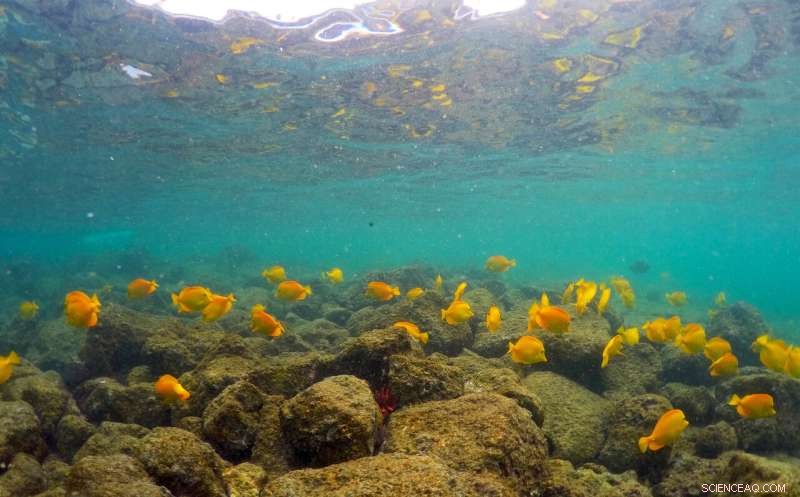
In this Sept. 12, photographies 2019, fish swim near bleaching coral in Kahala'u Bay in Kailua-Kona, Hawaii. Just four years after a major marine heat wave killed nearly half of this coastline's coral, federal researchers are predicting another round of hot water will cause some of the worst coral bleaching the region has ever seen. (Photo AP/Caleb Jones)
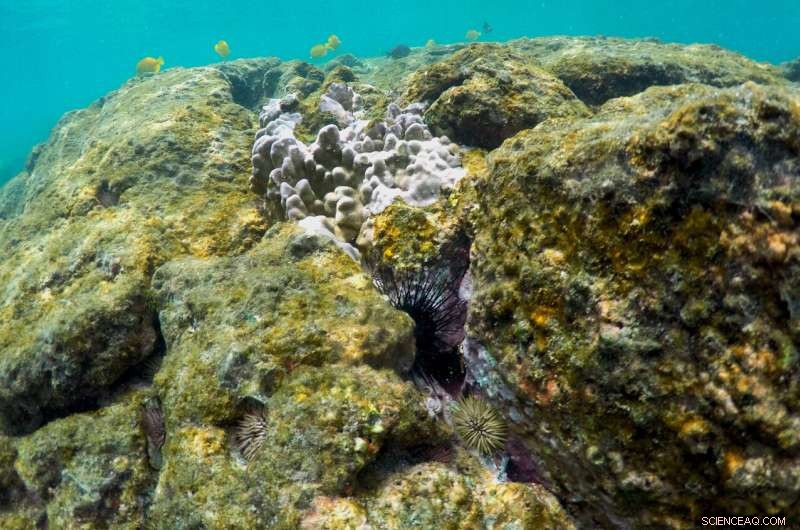
In this Sept. 12, photographies 2019, sea urchins and fish are seen near bleaching coral in Kahala'u Bay in Kailua-Kona, Hawaii. Just four years after a major marine heat wave killed nearly half of this coastline's coral, federal researchers are predicting another round of hot water will cause some of the worst coral bleaching the region has ever seen. (Photo AP/Caleb Jones)
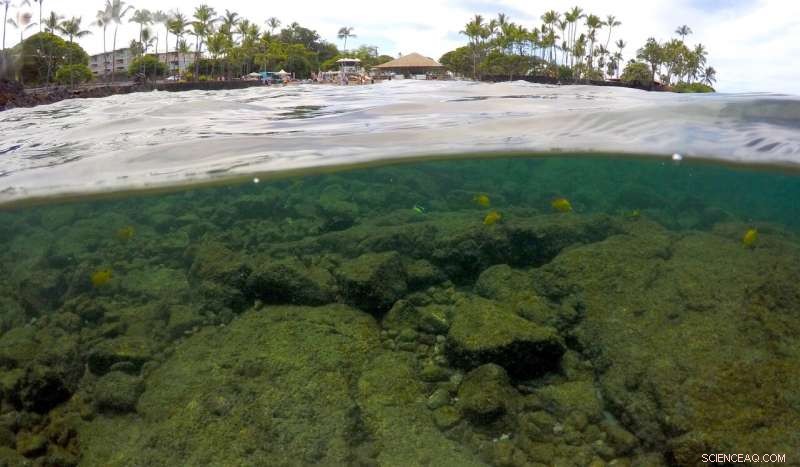
In this Sept. 12, photographies 2019, fish swim near bleaching coral in Kahala'u Bay in Kailua-Kona, Hawaii. Coral reefs are vital around the world as they not only provide a habitat for fish—the base of the marine food chain—but food and medicine for humans. They also create an essential shoreline barrier that breaks apart large ocean swells and protects densely populated shorelines from storm surges during hurricanes. (Photo AP/Caleb Jones)

In this Sept. 12, photographies 2019, visitors stand in Kahala'u Bay in Kailua-Kona, Hawaii. Hawaii residents like Cindi Punihaole Kennedy are pitching in by volunteering to educate tourists. Punihaole Kennedy is director of the Kahalu'u Bay Education Center, a nonprofit created to help protect Kahalu'u Bay, a popular snorkeling spot near the Big Island's tourist center of Kailua-Kona. (Photo AP/Caleb Jones)

This Sept. 13, 2019 photo shows a chunk of bleached, dead coral shown on a wall near a bay on the west coast of the Big Island near Captain Cook, Hawaii. Coral reefs are vital around the world as they not only provide a habitat for fish—the base of the marine food chain—but food and medicine for humans. They also create an essential shoreline barrier that breaks apart large ocean swells and protects densely populated shorelines from storm surges during hurricanes. (Photo AP/Caleb Jones)
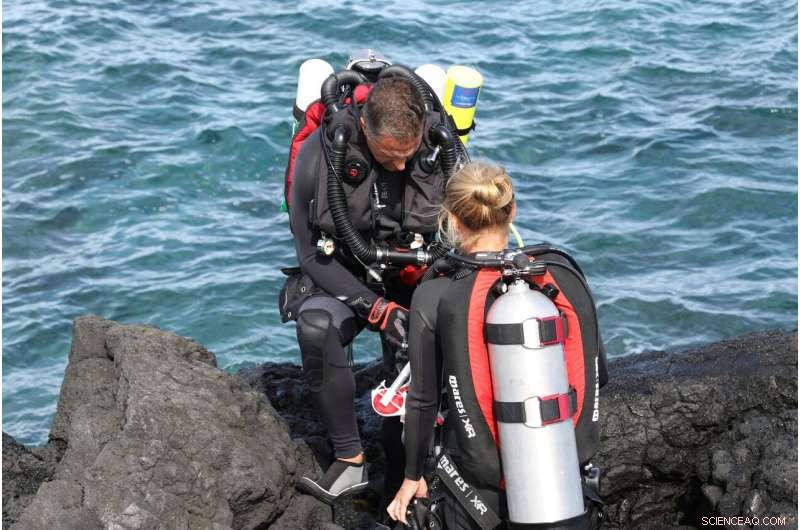
En ce 13 septembre, photographies 2019, researchers prepare to dive on a coral reef on the west coast of the Big Island near Captain Cook, Hawaii. One of the state's most vibrant coral reefs thrives just below the surface in a bay on the west coast of Hawaii's Big Island. Ici, on a remote shoreline far from the impacts of sunscreen and throngs of tourists, scientists see the early signs of what's expected to be a catastrophic season of coral bleaching in Hawaii. The ocean here is about three and a half degrees above normal for this time of year. Coral can recover from bleaching, but when it is exposed to heat over several years, the likelihood of survival decreases. (Photo AP/Caleb Jones)
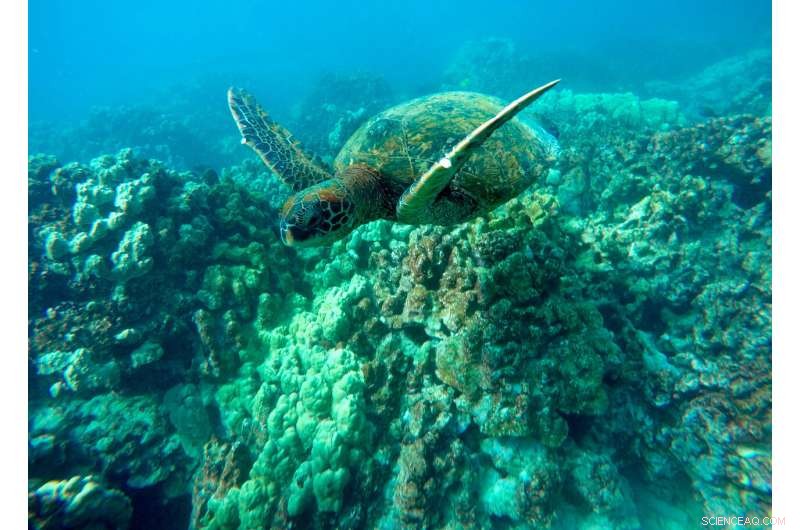
In this Sept. 11, photographies 2019, a green sea turtle swims near coral in a bay on the west coast of the Big Island near Captain Cook, Hawaii. Just four years after a major marine heat wave killed nearly half of this coastline's coral, federal researchers are predicting another round of hot water will cause some of the worst coral bleaching the region has ever seen. (AP Photo/Brian Skoloff)
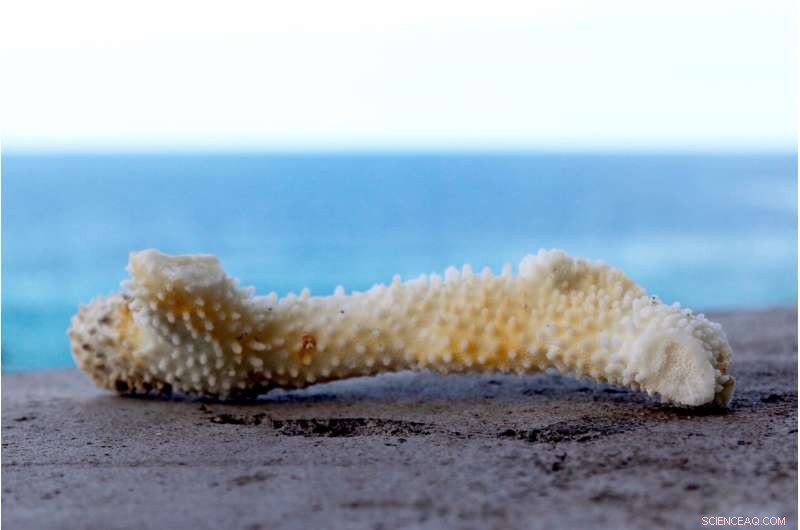
This Sept. 13, 2019 photo shows a chunk of bleached, dead coral shown on a wall near a bay on the west coast of the Big Island near Captain Cook, Hawaii. One of the state's most vibrant coral reefs thrives just below the surface in a bay on the west coast of Hawaii's Big Island. Ici, on a remote shoreline far from the impacts of sunscreen and throngs of tourists, scientists see the early signs of what's expected to be a catastrophic season of coral bleaching in Hawaii. The ocean here is about three and a half degrees above normal for this time of year. Coral can recover from bleaching, but when it is exposed to heat over several years, the likelihood of survival decreases. (Photo AP/Caleb Jones)

En ce 13 septembre, photographies 2019, ecologist Greg Asner, the director of Arizona State University's Center for Global Discovery and Conservation Science, reviews ocean temperature data at his lab on the west coast of the Big Island near Captain Cook, Hawaii. "Nearly every species that we monitor has at least some bleaching, " said Asner after a dive in Papa Bay. (AP Photo/Caleb Jones)

En ce 16 septembre, photographies 2019, National Oceanic and Atmospheric Administration oceanographer Jamison Gove talks about coral bleaching at the NOAA regional office in Honolulu. U.S. federal researchers in Hawaii say ocean temperatures around the archipelago are on track to match or even surpass records set in 2015, the hottest year on record for the Pacific Ocean. They predict that heat will cause some of the worst coral bleaching and mortality the region has ever seen. (Photo AP/Caleb Jones)
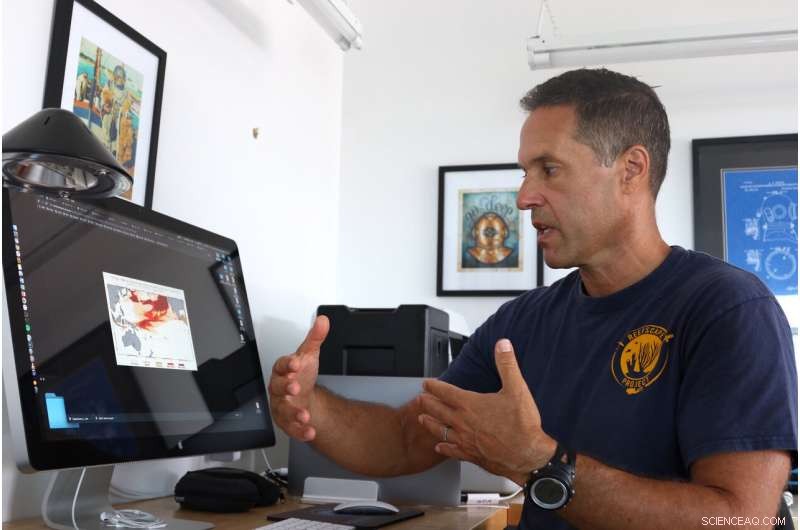
En ce 13 septembre, photographies 2019, ecologist Greg Asner, the director of Arizona State University's Center for Global Discovery and Conservation Science, reviews ocean temperature data at his lab on the west coast of the Big Island near Captain Cook, Hawaii. "Nearly every species that we monitor has at least some bleaching, " said Asner after a dive in Papa Bay. (AP Photo/Caleb Jones)
The bay suffered widespread bleaching and coral death in 2015.
"It was devastating for us to not be able to do anything, " Punihaole Kennedy said. "We just watched the corals die."
© 2019 La Presse Associée. Tous les droits sont réservés.